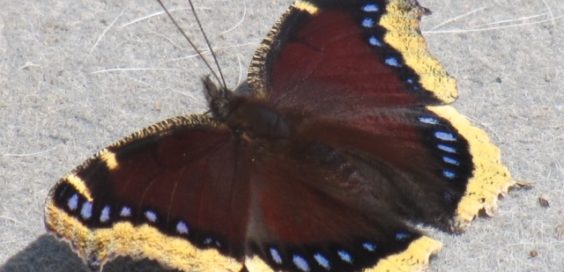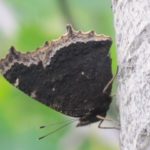
Creature Feature – The Mourning Cloak Butterfly
Posted by Dustin Horton // March 20, 2019 // Articles, Creature Feature
I’m in awe of seemingly fragile things that survive our brutal winters, like delicate butterflies. Among the first species of butterflies to emerge in springtime, often while snow lingers on the ground, is the mourning cloak. Named for the somber dark brown color of its outer (closed) wings, its inner (open) wings are quite lovely, with a row of bright blue spots and a creamy yellow or beige border. When resting on a dark tree trunk or branch, the closed wings resemble bark, offering protective camouflage. They flit about, seeking tree sap, their main food source. So how do these delicate beauties survive the winter? Mourning cloaks hibernate as adults, tucked away in hollow logs or other sheltered nooks. They overwinter in a stage called “diapause,” where metabolic and respiratory rates are reduced. To keep from freezing, they reduce the amount of water in their blood and replace it with antifreeze agents like glycerol and sorbitol. This process is triggered by shorter daylight hours as summer progresses and takes time to complete by the onset of cold weather. To protect them from freezing after a false spring, diapause is only reversed after a sustained period of winter is met and days lengthen. Mourning cloaks often emerge in spring looking tattered and worn, as they are 8-9 months old. Ironically, these amazing winter warriors will die shortly after mating in the spring.
Article and photos by Margie Manthey















